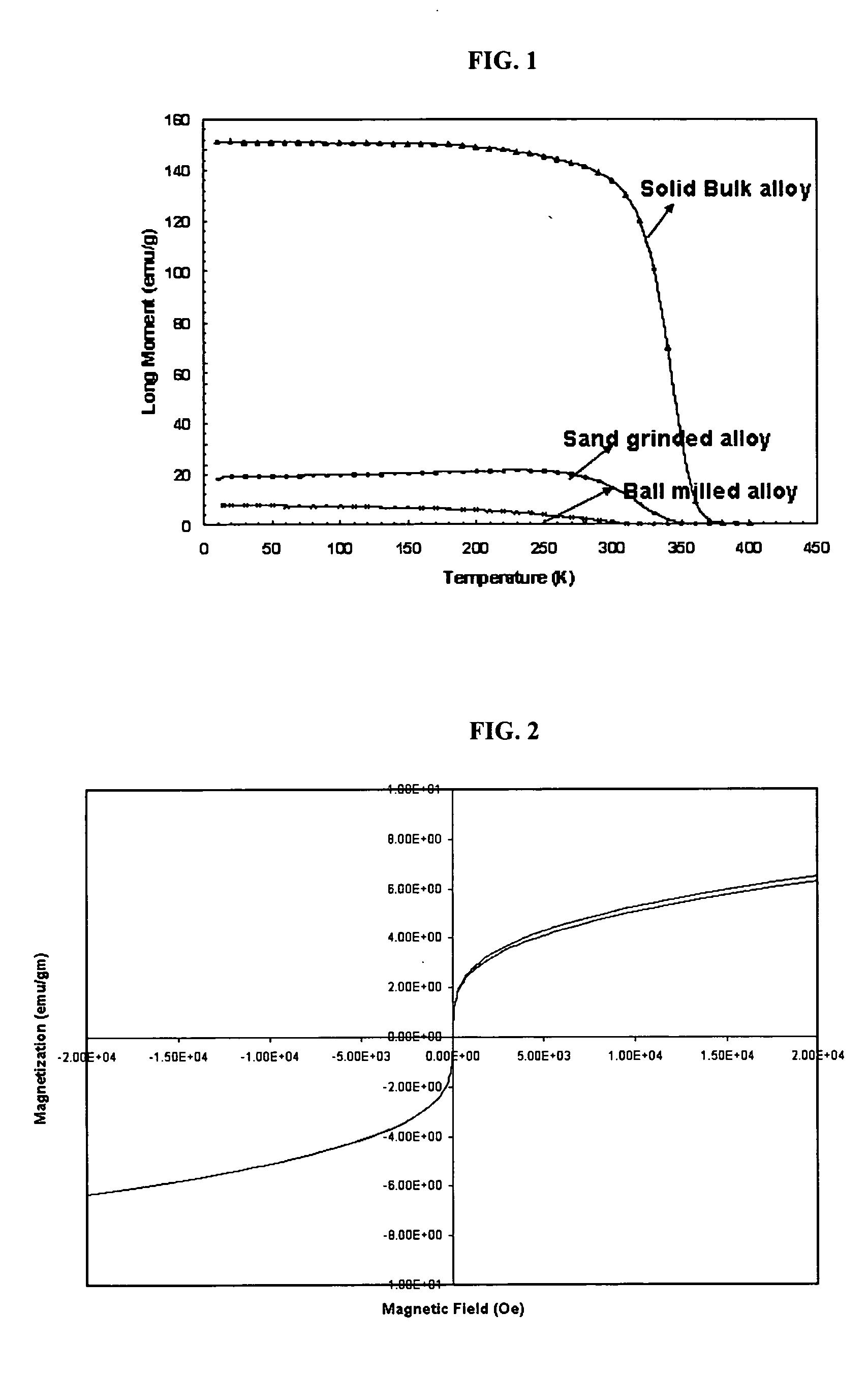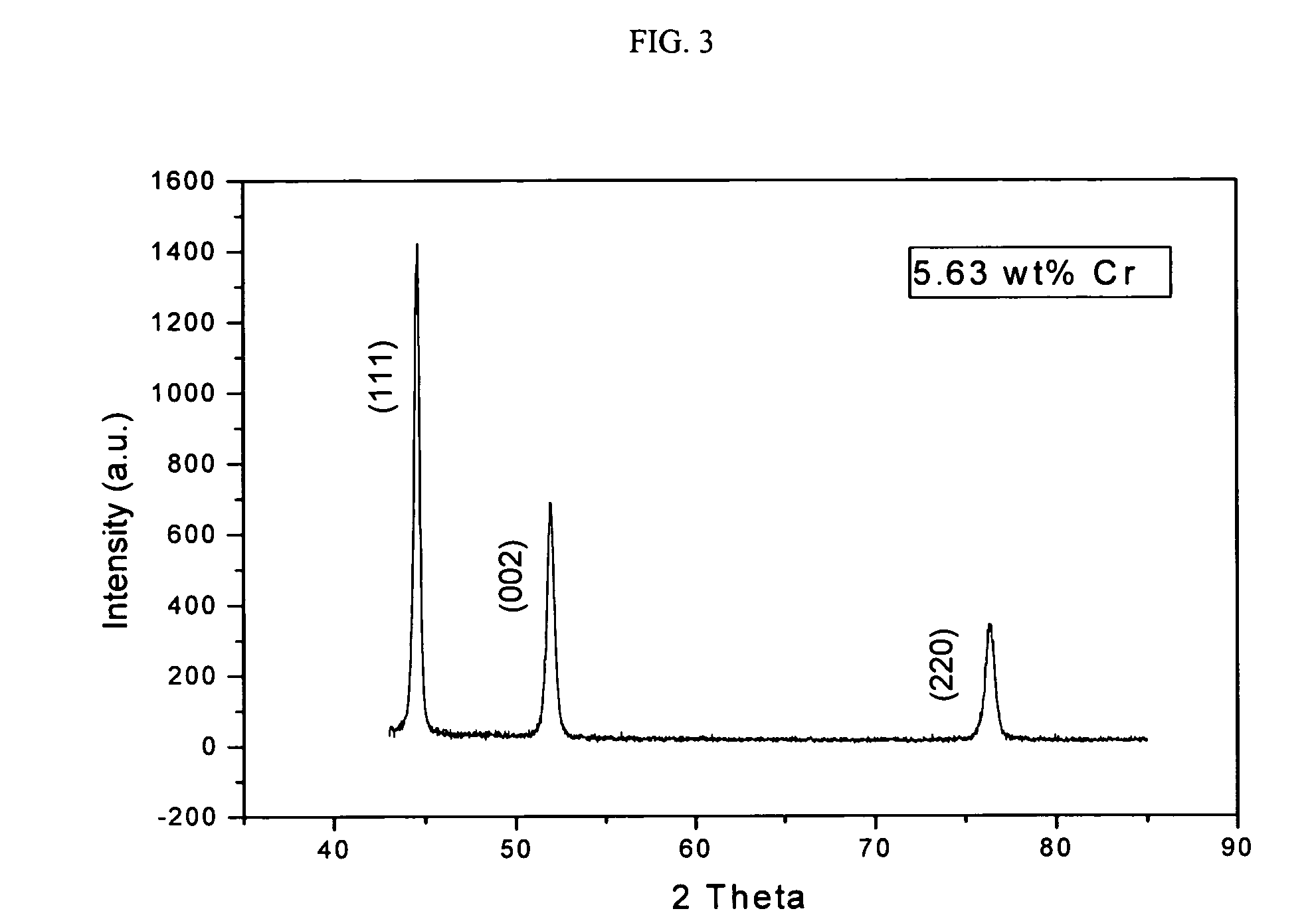Magnetic particle composition for therapeutic hyperthermia
a technology of magnetic particles and compositions, applied in the field of magnetic nanoparticle compositions, can solve the problems of affecting the clinical utility of each approach, unable to and inability to excision, etc., and achieve the effect of generating hysteresis hea
- Summary
- Abstract
- Description
- Claims
- Application Information
AI Technical Summary
Benefits of technology
Problems solved by technology
Method used
Image
Examples
example 1
Physically Synthesized Nickel-Copper Nanoparticles for Magnetic Hyperthermia
[0066] Nanoparticles, which consisted of a binary alloy of copper-nickel, having a preselected Curie temperature, were made.
[0067] The phase equilibria system for copper-nickel shows a linear progression for the Curie temperature, which starts at a composition of 67% nickel and 33% copper (by weight) for a temperature of 0° C. (Chakrabarti et al., Binary alloy phase diagrams, Materials Park, Ohio, 1990 Massalski et al. (editors)). From the Cu—Ni alloy phase diagram, the optimum amount of nickel in the alloy was selected to be 71-71.4% by weight, in order to yield an alloy having a Curie temperature in the range of 41 to 46° C.
[0068] The nanoparticles were made by process that combined melting and ball milling of bulk materials. The nickel-copper alloy was obtained via physical melting, in which nickel powder (AlfaAesar, 325 mesh, 99%) and copper powder (AlfaAesar, 500 mesh, 99%) were mixed in the desired ...
example 2
Synthesis of Nickel-Chromium (Ni1-xCrx) Nanoparticles
[0075] A series of Ni1-xCrx alloys were prepared to find the specific composition that has a Curie temperature around 316-317 K. Magnetic properties of the samples were investigated, including Curie temperature, saturation magnetization and hysteresis. The Curie temperatures of the alloys were decreased from 401 K to 289 K, while increasing the Cr concentration from x=4.54 wt % to x=5.90 wt %. The results showed that (Ni1-xCrx) alloys are good candidates for self regulating magnetic hyperthermia applications, because the Curie temperature of the alloys decreases almost linearly with increasing Cr concentration.
[0076] A series of NiCr binary alloys were prepared from nickel and chromium metals with 99.9% purity under a argon gas atmosphere by a standard arc melting technique. The samples were turned over and re-melted three times to ensure homogeneity. Finally the samples were annealed in argon gas filled and sealed quartz tubes ...
example 3
Gadolinium Substitution on Mn—Zn-Ferrite Nanoparticles
[0080] Mn—Zn ferrite and Gd substituted Mn—Zn ferrite nanoparticles were synthesized using a chemical co-precipitation method to obtain low Curie temperature magnetic particles with a moderately high value of magnetization and a high pyromagnetic coefficient. The magnetic properties and temperature dependence of these particles, and the effect of varying Gd proportions, were studied. The particles exhibited properties that make would make them worth considering for hyperthermia applications.
[0081] Mn—Zn-ferrite particles and Gd substituted Mn—Zn-Ferrite particles were obtained via chemical co-precipitation and ferritization. First, the metal salts were co-precipitated into hydroxides. This was done by addition of aqueous solution of metal salts in water to the coprecipitating base (e.g. NaOH, CH3NH3OH etc.). For the case of Mn—Zn Ferrite particles the reaction occurs as follows:
Then this precipitate is transformed into ferri...
PUM
| Property | Measurement | Unit |
|---|---|---|
| Temperature | aaaaa | aaaaa |
| Temperature | aaaaa | aaaaa |
| Temperature | aaaaa | aaaaa |
Abstract
Description
Claims
Application Information
 Login to View More
Login to View More - R&D
- Intellectual Property
- Life Sciences
- Materials
- Tech Scout
- Unparalleled Data Quality
- Higher Quality Content
- 60% Fewer Hallucinations
Browse by: Latest US Patents, China's latest patents, Technical Efficacy Thesaurus, Application Domain, Technology Topic, Popular Technical Reports.
© 2025 PatSnap. All rights reserved.Legal|Privacy policy|Modern Slavery Act Transparency Statement|Sitemap|About US| Contact US: help@patsnap.com



